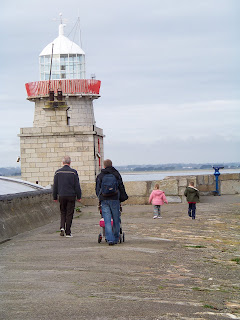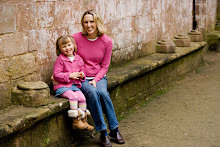The kids had last week off from school, so we thought we should take a short trip to one of the places on our list. Our destination this time was Dublin, Ireland!
We flew out very early last Monday, and arrived at Dublin Airport before 10am (the flight from here was less than an hour). From the airport, we took a taxi to a small coastal town just north of Dublin called Howth (pronounced "Hoat"). With all of our carry-on luggage stuffed in the stroller basket and around our shoulders, we took a lovely stroll around the town, beginning with a walk along the pier.



How delighted we were to have the sun actually come out than morning. Irish eyes were truly smiling on us!
The island that you can see off the coast here is called Ireland's Eye.


There's actually an 8th century church on this island which used to function as a parish church for the village of Howth. Today, the island is mainly an animal sanctuary, and many seals and sea birds reside on the island.
We stopped for lunch and got some delicious take-away Fish-n-Chips which we enjoyed eating on a bench overlooking the harbor.

After lunch and some time on the community playground, we found the train station and took the DART train into Dublin.
We reached Dublin too early to check into our hotel, so we decided to walk to Trinity College for some sight-seeing. The foundations for Trinity College were laid back in the late 1500s, so you can imagine what an important element it is to the city.

The college was just beautiful... cobblestone lined walkways, both historical and modern architectural elements.


Our main destination within the college walls was the Library (I know, it seems like a pretty boring place to go if you're a tourist). However, the library contains an exhibit on the Book of Kells, which was highly recommended.
The Book of Kells is a Latin manuscript of the four gospels from the New Testament. It was transcribed by Celtic monks circa 800AD. Historians don't know the exact details regarding its inception, but what is so remarkable about the manuscript is how unbeliveably ornate it is!!! The decoration includes Christian icons and symbology, along with what we characterize as Celtic design with its woven lines and swirled knots. We were able to read some history about the Book of Kells, learn about its symbolism, and see how the book was actually made (i.e. how they would produce colored ink during that time and how they would bind it). At the end of the exhibit, you could see a few of the actual pages on display.
Here are a few examples of what we saw:

This page is a drawing of the four authors of the gospels. You can see that they were basically mythologized in their character.

And we got to see the actual page of this last example which is Christ's genealogy.

After the exhibit, we headed upstairs to see what is known as the Long Room of the Library. You can see how it got its name!

My jaw dropped as I walked into this room. It was the perfect image of what an old college library should look like, with thousands upon thousands of books, sliding ladders reaching to the top shelves... it was amazing!
After we left Trinity, we decided to head to our hotel. On the way, we stumbled upon Grafton Street, which is a big shopping area in the city.

We also came upon a Butler's Chocolate Cafe. Our local friend in our village who attended Trinity College recommended that we try the white hot chocolate there. I have to tell you... it was heaven in a cup. Oh my gosh, was it good!!

We sipped our white hot chocolate all the way to our hotel, where we settled in for the night. We only went out again to buy a ridiculously small and expensive pizza for the four of us (Dublin is expensive!), quickly followed by a trip to a small grocery store where we bought more food to bring back to our hotel room.
We all slept well that night......
 Much bigger than we expected! The kids had fun with some sparklers,
Much bigger than we expected! The kids had fun with some sparklers,

 and the fireworks were as good as any we had seen in the U.S. of A.
and the fireworks were as good as any we had seen in the U.S. of A.  A fun night for all!
A fun night for all!


















































